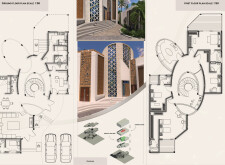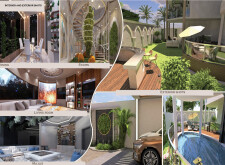5 key facts about this project
## House of the Future, United Arab Emirates
### Overview
Situated in the United Arab Emirates, the House of the Future merges traditional and contemporary architectural principles, reflecting the region's cultural heritage while addressing modern sustainability challenges. The design philosophy is grounded in the words of Sheikh Zayed, emphasizing the interconnectedness of past, present, and future, which is expressed through the architectural form and materials used. The project embodies a narrative that honors historical roots while anticipating future living standards aligned with environmental sustainability.
### Spatial Strategy
The architectural layout features a series of elliptical cores and interconnected spaces, fostering dynamic interactions between indoor and outdoor areas. A prominent central staircase not only serves as a functional element but also enhances connectivity throughout the residence. The incorporation of traditional Meshrabiya screens serves both aesthetic and environmental functions, optimizing shading and ventilation, critical for comfort in the UAE's climate. The arrangement creates a harmonious flow and facilitates social interaction, reflecting the communal values inherent in UAE culture.
### Materiality and Sustainability
A diverse palette of materials has been selected to reinforce both sensory experience and ecological responsibility. Durable concrete forms the structural basis, while extensive glass integration facilitates natural lighting and visual continuity with the surrounding landscape. Customized wooden lattices draw on cultural motifs and enhance interior aesthetics, contributing to the home's character. The project's sustainable focus includes features such as solar panels for energy efficiency, advanced cooling strategies leveraging the elliptical core for natural ventilation, and systems for rainwater harvesting, underpinning its commitment to environmental stewardship. Overall, these design choices exemplify a forward-thinking approach in harmonizing heritage with contemporary ecological practices.























































